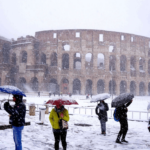When selecting a destination for solo backpacking, it is essential to consider various factors to ensure a safe and enjoyable experience. Key considerations include the local culture, language barriers, and overall atmosphere of the destination. Some solo travelers prefer urban environments with active nightlife and numerous attractions, while others seek out more remote, natural settings for a peaceful experience.
Thorough research of potential destinations is crucial to ensure they meet individual criteria and offer desired experiences. The season and weather conditions of the chosen location should also be taken into account, as these can significantly impact the solo backpacking experience. For those new to solo backpacking, certain destinations are particularly well-suited due to their reputation for being solo traveler-friendly.
Southeast Asia is a popular choice for first-time solo backpackers, offering affordability, established backpacker infrastructure, and a high likelihood of encountering other solo travelers. European cities such as Amsterdam and Berlin are also known for their welcoming atmosphere towards solo travelers, featuring numerous hostels and social activities catering to independent tourists. The ideal destination for a solo backpacking trip ultimately depends on personal preferences, comfort level, and specific travel objectives.
Key Takeaways
- Research and choose a destination that aligns with your interests and travel style for a fulfilling solo backpacking experience.
- Pack light and include essentials like a first aid kit, multi-purpose clothing, and a reliable backpack for convenience and comfort during your trip.
- Prioritize safety by staying aware of your surroundings, sharing your itinerary with someone you trust, and trusting your instincts while solo backpacking.
- Set a realistic budget that covers transportation, accommodation, food, and activities to avoid financial stress during your solo backpacking trip.
- Plan a flexible itinerary that allows for spontaneity while ensuring you have a general idea of where you’ll be and when, for a balanced solo backpacking adventure.
Packing Essentials for Solo Backpacking
The Basics
Start with the essentials: a sturdy and comfortable backpack, lightweight clothing suitable for the climate of your destination, and versatile footwear for walking and hiking. It’s also important to pack a first aid kit with essential medical supplies, as well as any necessary medications.
Staying Connected and Informed
Additionally, consider packing a portable charger for your electronic devices, a travel adapter if you’re visiting a different country, and a reliable travel guide or map.
Personal Safety and Comfort
When it comes to personal safety, it’s important to pack items such as a money belt or neck pouch to keep your valuables secure, a padlock for hostel lockers, and a whistle or personal alarm for emergencies. It’s also wise to carry photocopies of important documents such as your passport and travel insurance information, as well as a small amount of local currency for emergencies. Don’t forget to pack some comfort items to make your solo backpacking experience more enjoyable, such as a good book, a journal, or a travel-friendly board game.
Safety Tips for Solo Backpacking
Solo backpacking can be an incredibly rewarding experience, but it’s important to prioritize safety throughout your journey. One of the most crucial safety tips for solo backpackers is to trust your instincts and be aware of your surroundings at all times. If something feels off or unsafe, don’t hesitate to remove yourself from the situation and seek help if necessary.
It’s also wise to stay connected with friends and family back home by regularly checking in with them and sharing your itinerary. Consider using a tracking app or sharing your location with trusted contacts for added peace of mind. Another important safety tip for solo backpackers is to avoid drawing unnecessary attention to yourself and your belongings.
Keep your valuables secure and out of sight, be mindful of displaying expensive items such as cameras or jewelry, and avoid sharing personal details with strangers. Additionally, it’s wise to research local customs and cultural norms to ensure that you’re respectful and mindful of local sensitivities. Finally, consider enrolling in a travel safety course or self-defense class before embarking on your solo backpacking trip to feel more confident in your ability to handle unexpected situations.
By prioritizing safety and taking proactive measures to protect yourself, you can enjoy your solo backpacking adventure with greater peace of mind.
Budgeting for Your Solo Backpacking Trip
| Expenses | Estimated Cost |
|---|---|
| Accommodation | 300 |
| Food | 200 |
| Transportation | 150 |
| Travel Insurance | 100 |
| Activities | 250 |
| Emergency Fund | 200 |
| Total | 1200 |
Budgeting is a crucial aspect of planning any travel adventure, especially when it comes to solo backpacking. Before setting off on your journey, take the time to carefully assess your financial situation and establish a realistic budget for your trip. Consider expenses such as transportation, accommodation, food, activities, travel insurance, and any additional costs specific to your chosen destination.
Research the average daily expenses in your destination country or region to get an idea of how much you’ll need to budget for each day. When it comes to managing your budget while solo backpacking, there are several strategies you can employ to stretch your funds further. Consider staying in budget-friendly accommodation options such as hostels or guesthouses, cooking some of your own meals instead of dining out for every meal, and taking advantage of free or low-cost activities such as hiking or visiting public parks.
Additionally, be mindful of unnecessary expenses such as impulse purchases or excessive nightlife spending. By keeping track of your expenses and making conscious choices about where to allocate your funds, you can make the most of your budget while still enjoying a fulfilling solo backpacking experience.
Planning Your Itinerary
Planning your itinerary is an essential part of preparing for a solo backpacking trip. Start by researching the must-see attractions and activities in your chosen destination, as well as any off-the-beaten-path gems that align with your interests. Consider factors such as transportation options, opening hours of attractions, and any seasonal events or festivals that may be taking place during your visit.
It’s also important to be realistic about how much you can comfortably fit into each day without feeling rushed or overwhelmed. When planning your itinerary as a solo backpacker, it’s important to strike a balance between structured plans and flexibility. While it’s beneficial to have a rough outline of your daily activities and accommodations booked in advance, allow yourself some room for spontaneity and unexpected discoveries along the way.
Leave some open days in your itinerary for rest and relaxation or to explore new opportunities that arise during your travels. Additionally, consider seeking out local recommendations from fellow travelers or hostel staff to uncover hidden gems that may not be found in traditional guidebooks. By planning thoughtfully and remaining open to new experiences, you can create an itinerary that maximizes your solo backpacking adventure.
Finding Accommodation as a Solo Backpacker

Popular Accommodation Options for Solo Backpackers
Hostels are a popular choice for solo backpackers due to their affordability, social atmosphere, and the opportunity to connect with fellow travelers from around the world. Many hostels offer dormitory-style rooms as well as private rooms for those seeking more privacy.
Other Affordable and Comfortable Options
In addition to hostels, guesthouses, homestays, and budget hotels are also viable options for solo backpackers looking for affordable and comfortable accommodation.
Choosing the Right Accommodation for Your Needs
When choosing accommodation as a solo traveler, consider factors such as location, safety, cleanliness, and any additional amenities or services offered by the property. It’s also wise to read reviews from previous guests to get an idea of the overall atmosphere and quality of the accommodation. Finally, consider reaching out to fellow travelers or online communities for recommendations on accommodation options that are particularly well-suited for solo backpackers. By carefully selecting accommodation that meets your needs and preferences, you can enhance your solo backpacking experience and create lasting memories along the way.
Embracing the Solo Backpacking Experience
Embracing the solo backpacking experience is about more than just navigating new destinations on your own – it’s about embracing independence, self-discovery, and personal growth. As a solo backpacker, you have the freedom to set your own pace, make spontaneous decisions, and fully immerse yourself in each new experience without compromise. Embrace the opportunity to step outside of your comfort zone, connect with locals and fellow travelers from diverse backgrounds, and gain a deeper understanding of the world around you.
Solo backpacking also offers the chance for introspection and self-reflection as you navigate new environments and face unexpected challenges along the way. Use this time alone to reconnect with yourself, set personal goals for growth and self-improvement, and gain a renewed sense of confidence in your abilities. Embrace the moments of solitude as opportunities for mindfulness and self-care, whether it’s through journaling, meditation, or simply taking in the beauty of your surroundings.
Finally, embrace the connections you make along the way – whether it’s with fellow travelers at a hostel, locals who share their stories with you, or chance encounters that leave a lasting impact. These connections have the power to enrich your solo backpacking experience in ways you may not have anticipated. Embracing the solo backpacking experience is about embracing the freedom to create your own adventure while remaining open to the unexpected twists and turns that make travel so rewarding.
If you’re looking to plan a solo backpacking trip, you might want to check out this article on Rome Retreats. They offer tips and advice on how to plan a successful solo backpacking adventure, including choosing the right destination, packing essentials, and staying safe while traveling alone. It’s a great resource for anyone looking to embark on a solo adventure and make the most of their backpacking experience.
FAQs
What is solo backpacking?
Solo backpacking is the act of traveling alone with all of your belongings in a backpack, typically for an extended period of time. It often involves hiking, camping, and exploring remote or wilderness areas.
Why plan a solo backpacking trip?
Solo backpacking allows for independence, self-discovery, and the freedom to explore at your own pace. It can also be a way to challenge yourself and build confidence.
What are the essential items to pack for a solo backpacking trip?
Essential items for a solo backpacking trip include a reliable backpack, tent, sleeping bag, cooking equipment, food and water, navigation tools, first aid kit, appropriate clothing, and personal hygiene items.
How do you choose a destination for a solo backpacking trip?
When choosing a destination for a solo backpacking trip, consider factors such as your experience level, the time of year, the terrain and climate, and any permits or regulations that may apply to the area.
What safety precautions should be taken for a solo backpacking trip?
Safety precautions for a solo backpacking trip include informing someone of your itinerary, carrying a means of communication (such as a satellite phone or personal locator beacon), being aware of wildlife and potential hazards, and having the necessary skills and knowledge for the trip.
How do you stay motivated and mentally prepared during a solo backpacking trip?
To stay motivated and mentally prepared during a solo backpacking trip, set realistic goals, practice mindfulness and self-care, stay connected with loved ones when possible, and be open to the experiences and challenges that arise.









